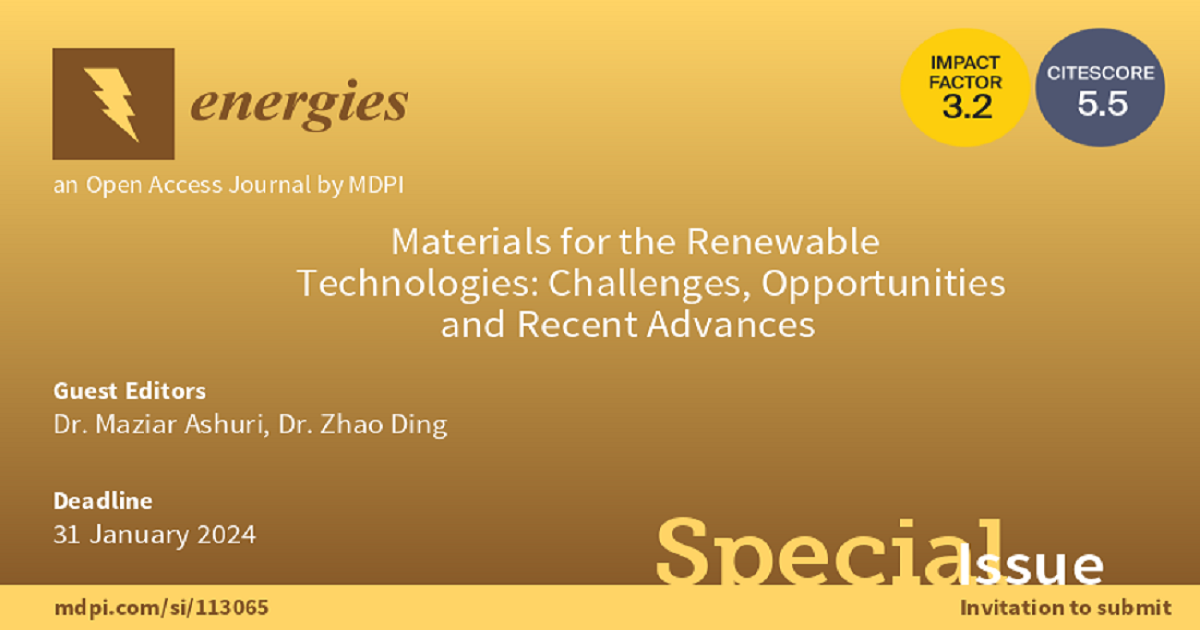- 3.2Impact Factor
- 7.3CiteScore
- 17 daysTime to First Decision
Materials for the Renewable Technologies: Challenges, Opportunities and Recent Advances
This special issue belongs to the section “D1: Advanced Energy Materials“.
Special Issue Information
Dear Colleagues,
The emerging need to produce and store electricity is a critical challenge for the 21st century. In addition to maintaining the balance in the electric grid and preventing any shortage, it is crucial to store energy at off-peak periods and release it when the load is high. Currently, electricity production primarily relies on the burning of fossil fuels. Because of the limited resources for fossil fuels and severe environmental damages associated with their usage, it is crucial to switch to renewable energies such as solar, geothermal, wind, biomass, etc.
To enhance the performance, efficiency, and safety of renewable energy storage/conversion devices, it is important to develop a solid understanding of their underlying operation and failure mechanisms. Adjustment of materials properties for each application is vital, since in most cases the performance is limited by the intrinsic properties of the active materials. Despite the tremendous efforts to push the materials performance beyond their limits, there is still a huge gap between the industrial standards and the current academic research which needs to be filled. This motivated us to dedicate a Special Issue of Energies to collect the most recent advances in the field of materials development for renewable technologies. We invite all researchers to publish their original research, whether it is purely fundamental or application-oriented, in the forms of research papers, reviews, or short communications. The proposed topics are listed below.
- Supercapacitors.
- Photovoltaic Cells.
- Fuel cells (including polymer electrolyte membrane, molten salt, solid oxide fuel cells etc.).
- Lithium batteries (including Li-ion, Li-sulfur, Li-metal, Li-air, all-solid-state batteries etc.).
- Beyond lithium batteries (including different chemistries such as Na, K, Mg, Al Batteries).
- Redox flow batteries.
- Renewable technologies recycling.
We kindly invite you to submit your relevant work in the field of “Materials for the Renewable Technologies: Challenges, Opportunities and Recent Advances” for consideration for publication.
Dr. Maziar Ashuri
Dr. Zhao Ding
Guest Editors
Manuscript Submission Information
Manuscripts should be submitted online at www.mdpi.com by registering and logging in to this website. Once you are registered, click here to go to the submission form. Manuscripts can be submitted until the deadline. All submissions that pass pre-check are peer-reviewed. Accepted papers will be published continuously in the journal (as soon as accepted) and will be listed together on the special issue website. Research articles, review articles as well as short communications are invited. For planned papers, a title and short abstract (about 250 words) can be sent to the Editorial Office for assessment.
Submitted manuscripts should not have been published previously, nor be under consideration for publication elsewhere (except conference proceedings papers). All manuscripts are thoroughly refereed through a single-blind peer-review process. A guide for authors and other relevant information for submission of manuscripts is available on the Instructions for Authors page. Energies is an international peer-reviewed open access semimonthly journal published by MDPI.
Please visit the Instructions for Authors page before submitting a manuscript. The Article Processing Charge (APC) for publication in this open access journal is 2600 CHF (Swiss Francs). Submitted papers should be well formatted and use good English. Authors may use MDPI's English editing service prior to publication or during author revisions.
Keywords
- Li-Ion Batteries
- Beyond Li-Ion Batteries (including Na-ion batteries, K-ion batteries, multivalent batteries, all-solid-state batteries etc.)
- Supercapacitors (including electrochemical double-layer capacitors, pseudocapacitors, hybrid capacitors)
- Fuel Cells (including polymer electrolyte membrane, direct methanol, alkaline, molten carbonate, phosphoric acid, solid oxide fuel cells etc.).
- Solar Photovoltaic Cells (including crystalline silicon, perovskite, dye-sensitized, photoelectrochemical, organic, solid-state, hybrid solar cells etc.)
- Redox Flow Batteries (including inorganic, organic, semi-solid, hybrid flow batteries etc.)
- Renewable Technologies Recycling

Benefits of Publishing in a Special Issue
- Ease of navigation: Grouping papers by topic helps scholars navigate broad scope journals more efficiently.
- Greater discoverability: Special Issues support the reach and impact of scientific research. Articles in Special Issues are more discoverable and cited more frequently.
- Expansion of research network: Special Issues facilitate connections among authors, fostering scientific collaborations.
- External promotion: Articles in Special Issues are often promoted through the journal's social media, increasing their visibility.
- e-Book format: Special Issues with more than 10 articles can be published as dedicated e-books, ensuring wide and rapid dissemination.

